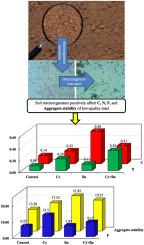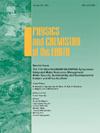利用当地微生物改善泥灰岩土壤的主要质量指标
IF 3
3区 地球科学
Q2 GEOSCIENCES, MULTIDISCIPLINARY
引用次数: 0
摘要
生物土壤板结对干旱和半干旱地区生态系统的生产力至关重要,其中蓝藻(Cy)和细菌(Ba)起着举足轻重的作用。这些微生物通过分泌多糖来改善营养条件、土壤稳定性、土壤肥力和饲料质量。然而,目前还缺乏针对土壤物理和化学性质变化的全面定量研究。本研究调查了单独或联合接种 Cy 和 Ba 对马尔扎纳巴德地区低质土壤牧场质量的影响。评估的土壤质量指标包括碳(C)含量、氮(N)含量、碳/氮比、土壤可利用磷(P)含量和团粒稳定性。研究结果表明,微生物接种对氮浓度、可利用磷和团粒稳定性有显著影响(p < 0.01)。此外,与对照组相比,Cy 和 Ba 的单独和组合处理使 C 含量分别增加了 57.14%、297.14% 和 120%。这些处理中的氮浓度分别比对照土壤高出 150%、37.50% 和 325%。在可吸收钾方面,与对照相比分别增加了 105.48%、6.54% 和 39.57%。此外,微生物的表层接种增强了聚集粘附力,与对照处理相比,单独处理以及 Cy 和 Ba 组合处理的稳定性分别提高了 29.20%、61.65% 和 42.11%。研究结果表明,利用土壤微生物恢复干旱和半干旱地区的植被是一种可行的策略。本文章由计算机程序翻译,如有差异,请以英文原文为准。

Improvability of quality main indices of a marl soil using endemic microorganisms
Biological soil crusts are essential for ecosystem productivity in arid and semiarid regions, where cyanobacteria (Cy) and bacteria (Ba) are pivotal. These microorganisms enhance nutritional conditions, soil stability, soil fertility, and forage quality through the secretion of polysaccharides. However, there is a lack of comprehensive quantitative studies addressing the changes in soil's physical and chemical properties. This research investigated the impact of individual and combined inoculations of Cy and Ba on the rangeland quality of low-quality soil in the Marzanabad region. The indicators of soil quality assessed included carbon (C) content, nitrogen (N) levels, C/N ratio, soil-available phosphorus (P), and aggregate stability. The findings indicated that microbial inoculation significantly (p < 0.01) affected N concentration, available P, and aggregate stability. Additionally, the individual and combined treatments of Cy and Ba resulted in increases in C content of 57.14%, 297.14%, and 120%, respectively, compared to the control. The N concentration in these treatments was 150%, 37.50%, and 325% higher than that of the control soil. In terms of absorbable P, increases of 105.48%, 6.54%, and 39.57% were observed compared to the control conditions. Furthermore, the superficial inoculation of microorganisms enhanced aggregation adhesion, with stability in the individual and combined Cy and Ba treatments increasing by 29.20%, 61.65%, and 42.11%, respectively, relative to the control treatment. The results of this study suggest that utilizing soil microorganisms to restore plant cover in arid and semiarid regions is a viable strategy.
求助全文
通过发布文献求助,成功后即可免费获取论文全文。
去求助
来源期刊

Physics and Chemistry of the Earth
地学-地球科学综合
CiteScore
5.40
自引率
2.70%
发文量
176
审稿时长
31.6 weeks
期刊介绍:
Physics and Chemistry of the Earth is an international interdisciplinary journal for the rapid publication of collections of refereed communications in separate thematic issues, either stemming from scientific meetings, or, especially compiled for the occasion. There is no restriction on the length of articles published in the journal. Physics and Chemistry of the Earth incorporates the separate Parts A, B and C which existed until the end of 2001.
Please note: the Editors are unable to consider submissions that are not invited or linked to a thematic issue. Please do not submit unsolicited papers.
The journal covers the following subject areas:
-Solid Earth and Geodesy:
(geology, geochemistry, tectonophysics, seismology, volcanology, palaeomagnetism and rock magnetism, electromagnetism and potential fields, marine and environmental geosciences as well as geodesy).
-Hydrology, Oceans and Atmosphere:
(hydrology and water resources research, engineering and management, oceanography and oceanic chemistry, shelf, sea, lake and river sciences, meteorology and atmospheric sciences incl. chemistry as well as climatology and glaciology).
-Solar-Terrestrial and Planetary Science:
(solar, heliospheric and solar-planetary sciences, geology, geophysics and atmospheric sciences of planets, satellites and small bodies as well as cosmochemistry and exobiology).
 求助内容:
求助内容: 应助结果提醒方式:
应助结果提醒方式:


